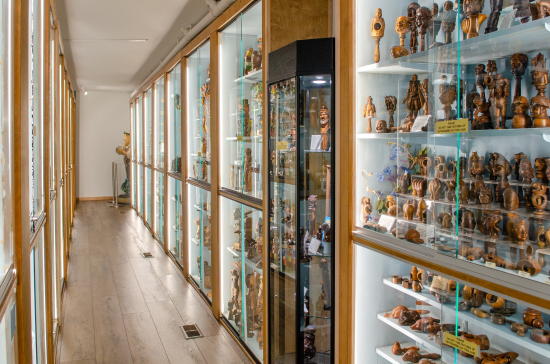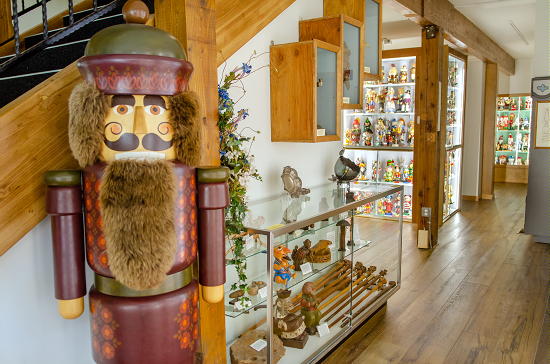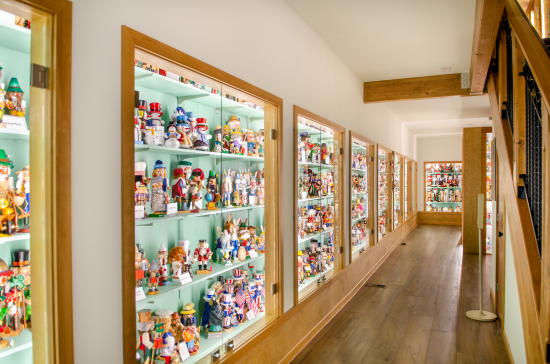|
TAKE A TOUR WITH ME…We
are so proud of our newly remodeled museum and want everyone to see
it, so come along with me as I love to show it off.
At the entrance, Karl, our mascot, greets you from a life size
poster. Karl himself is waiting anxiously at the back of the museum
where there is plenty of room for you to have your photo taken with
him.

Entering the aisle at Karl’s left you will see many antique
nutcrackers dating back to Roman times. There are both
lever and screw types shown in a variety of metals and woods. You
will find a Napoleon made in Sonneberg in 1820, a 16th century
King with a bird atop his head, and an intricately carved screw
dated 1631.

To Karl’s right is the viewing room with the introductory video
playing continually. You will also see a short History
of nutcrackers displayed attractively on wall panels, and a case
with nutcrackers depicting the traditional Erzgebirge miner’s band.

Past the entrance to the viewing room you will see Paul, the massive
Petersen nutcracker standing regally as he guards the magnificent
stairway that leads to the second level. Looking to the back past
Paul, you will get a glimpse of the children’s section and the 14
foot wall of Santa figures by Christian Steinbach and Christian
Ulbricht.

Around the corner of the wall of Santas a second wall of nearly 50
feet representing various national holidays and many festivals and
activities found in our Bavarian Village. Here you will see
nutcrackers representing Autumn Leaf Festival, Oktoberfest, Ice
Fest, the Fourth of July, Maifest, Christkindl Markt, Summer
Theater, Chef Fest, and even the popular Reindeer Farm.

Follow me for there is much more to see as we ascend the stairs to
the second level. Designed by Christina Zucktriegel,
Gary Pinckney, and Rusty Gibbs, this magnificent stairway truly
adds to the ambiance of the museum.

These striking banners and others throughout the museum show
interesting museum specimens, and were donated to the museum by
Lipscomb University of Nashville, Tennesee. In this
picture, looking at the case to the right, notice the brown clad
Hitler on the left in the top row. This was carved in
Sonneberg, Germany in 1938.

Other cases in the upper level display screw type nutcrackers in
metal, wood, porcelain, ivory and even rhinoceros horn. You
will see nutcrackers from 4 generations of the Ulbricht family, a
nutcracker carved on the end of a matchstick, King
Tut, and Star Wars figures. Preschoolers will find a
seal to complete their nutcracker hunt.

As we descend the stairs we are met with a display of betel cutters
from India and neighboring countries. Beside this case
is one of nutting stones dating back to the Archaic period (8000BC to
2000BC). In another case nearby you will find nutting
stones from the Sahara Desert, during the ancient time when it was
lush and green.

There is so much to see in the Nutcracker Museum, and I hope you
will come and tour it with me when the Nutcracker Museum reopens.
Please watch our website and Facebook page for COVID-19 updates.
|

 Nutcracker
Museum
Nutcracker
Museum








